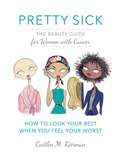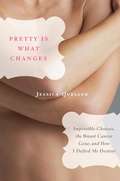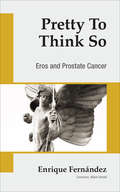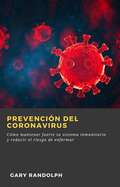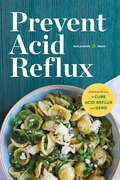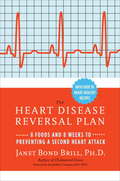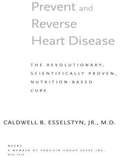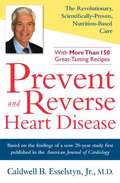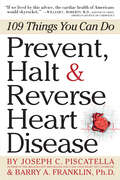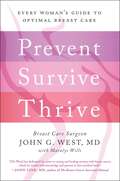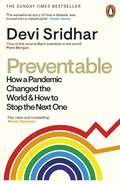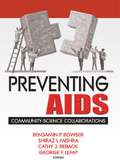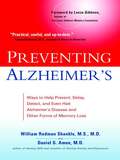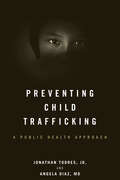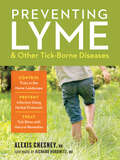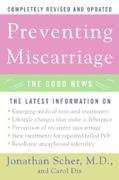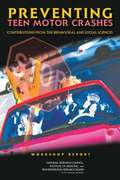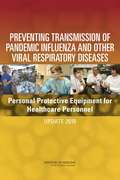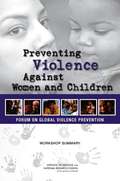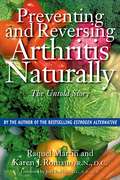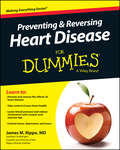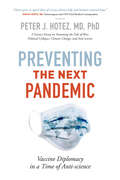- Table View
- List View
Pretty Sick: The Beauty Guide for Women with Cancer
by Caitlin M. KiernanThe ultimate resource to looking your best during and after cancer treatment from a veteran beauty industry insider When beauty editor Caitlin Kiernan received the shattering diagnosis of cancer, she was obviously concerned about her health. But as a working professional, she knew she had to learn, quickly, how to look her best while feeling her worst. Caitlin called on her list of extensive contacts--from top medical doctors to hair stylists, makeup artists, and style mavens--to gather the best and most useful tips to offset the unpleasant effects of treatment. The result is this comprehensive beauty guide for women with cancer, covering every cosmetic issue, from skin care, to hair care, wig shopping, nail maintenance, makeup tricks, and much, much more. Illustrated with charming drawings by Jamie Lee Reardin and peppered with advice from celebrities and cancer survivors, PRETTY SICK will be a welcome and trusted resource, helping women look and feel their best.
Pretty is What Changes: Impossible Choices, The Breast Cancer Gene and How I Defied My Destiny
by Jessica QuellerA TIMELY, AFFECTING MEMOIR FROM THE FRONT LINES OF MEDICAL SCIENCE: WHEN GENETICS CAN PREDICT HOW WE MAY DIE, HOW THEN DO WE DECIDE HOW TO LIVE? Eleven months after her mother succumbs to cancer, Jessica Queller has herself tested for the BRCA "breast cancer" gene mutation. The results come back positive, putting her at a terrifyingly elevated risk of developing breast cancer before the age of fifty and ovarian cancer in her lifetime. Thirty-four, unattached, and yearning for marriage and a family of her own, Queller faces an agonizing choice: a lifetime of vigilant screenings and a commitment to fight the disease when caught, or its radical alternative-a prophylactic double mastectomy that would effectively restore life to her, even as it would challenge her most closely held beliefs about body image, identity, and sexuality. Superbly informed and armed with surprising wit and style, Queller takes us on an odyssey from the frontiers of science to the private interiors of a woman's life. Pretty Is What Changes is an absorbing account of how she reaches her courageous decision and its physical, emotional, and philosophical consequences. It is also an incredibly moving story of what we inherit from our parents and how we fashion it into the stuff of our own lives, of mothers and daughters and sisters, and of the sisterhood that forms when women are united in battle against a common enemy. Without flinching, Jessica Queller answers a question we may one day face for ourselves: If genes can map our fates and their dark knowledge is offered to us, will we willingly trade innocence for the information that could save our lives? JESSICA QUELLER has written for numerous television shows, including Gossip Girl, Gilmore Girls, Felicity, and One Tree Hill. She lives in New York and Los Angeles.
Pretty to Think So: Eros and Prostrate Cancer
by Enrique FernándezThe renowned Cuban-American journalist reflects on a life of desire and the waning of sexuality after cancer treatment in this poignant memoir.“Two days ago, the effects of the androgen-deprivation shot a doctor’s assistant had injected under my skin a month earlier kicked in. And now I don’t want.” When a cancer diagnosis, and then various treatments, eliminate libido, the echoes of love and desire in the form of memories remain. What happens to a life when sexual expression is lost? Enrique Fernández’s Pretty to Think So weaves questions of sex, mortality, and identity with a lyricism that readers will not soon forget.
Prevención del Coronavirus: Cómo mantener fuerte tu sistema inmunitario y reducir el riesgo de enfermar
by Gary RandolphEste libro trata sobre la prevención del coronavirus y la generación de inmunidad. El coronavirus puede prevenirse mediante procedimientos estándar. Suele decirse que prevenir es mejor que curar, y esto es cierto en el caso de la prevención del coronavirus. Puede también prevenirse el coronavirus reforzando la inmunidad o manteniendo una inmunidad robusta. Algunas de las personas infectadas solo muestran síntomas que van de muy leves a moderados. Pero otras personas pueden ser propensas a desarrollar los síntomas extremos del COVID-19. Los datos médicos que aquí se proporcionan tienen por objeto ayudarnos a entender cuál es la mejor manera de protegernos y proteger a otras personas.
Prevenir la obesidad en los niños: Una cuestión de equilibrio
by José Antonio López Badiola Renée CyrEste libro presenta, desde un ángulo nuevo y muy dinámico, la importancia que tiene desarrollar en nuestros niños unos hábitos de vida saludables. La autora invita al lector a hacer un viaje a diferentes situaciones de la mano de unos personajes que a veces resultan divertidos, siempre inteligentes y que comparten con nosotros sus experiencias y conocimientos.
Prevent Acid Reflux: Delicious Recipes to Cure Acid Reflux and GERD
by Healdsburg PressLearn the healthy way to prevent acid reflux and GERD. Acid reflux and GERD are painful and frustrating medical issues that can lead to serious health complications. With Prevent Acid Reflux you will be able to fight acid reflux by making smart changes to your diet. Prevent Acid Reflux is your step-by-step guide to reducing acid in your diet so you can stop acid reflux in its tracks. Whether you occasionally suffer from acid reflux, or have been struggling for many years, Prevent Acid Reflux will help you make simple lifestyle changes that will eradicate the problem forever and permanently improve your quality of life. Prevent Acid Reflux will make it easy to get rid of acid reflux, GERD, and heartburn, with: Over 75 easy, delicious recipes to prevent and cure acid reflux and GERD 14-day meal plan to quickly eliminate acid reflux and GERD Tasty recipes that will relieve both mild and severe symptoms Q&A to determine whether the acid reflux diet is right for you Find out how a healthy diet can eliminate the pain of acid reflux forever. Prevent Acid Reflux will help you to enjoy delicious food again."
Prevent a Second Heart Attack
by Janet Bond Brill Annabelle S. VolgmanReverse Your Heart Disease in Just Eight WeeksIf you're one of the 13 million Americans who have survived a heart attack or been diagnosed with heart disease, Dr. Janet Bond Brill offers a delicious and foolproof plan that can lower your risk of a second heart attack by up to 70 percent. Inspired by the heart-healthy Mediterranean diet, the Prevent a Second Heart Attack Plan is based on satisfaction, rather than deprivation. Backed by cutting edge research, Dr. Brill explains:Why the Mediterranean diet is the gold standard of heart-healthy eatingHow "good carbs" such as oatmeal and popcorn lower bad cholesterol, prevent high blood pressure, and control your weightThe science behind eating fish for heart healthWhy having a glass of red wine with dinner is great for your heart--and which wines are the best choicesThe easiest, most delicious daily habit that will cut your heart attack riskPacked with every tool you need to eat your way to better heart health--including daily checklists, a complete two-week eating plan, and dozens of mouthwatering recipes to suit every meal, taste, and budget--Prevent a Second Heart Attack provides you with the knowledge, skills, and confidence to live long and enjoy the good life, the heart healthy way. JANET BOND BRILL, Ph.D., R.D., LDN, is a diet, nutrition, and fitness expert who has appeared on national television. She is the author of Cholesterol Down: 10 Simple Steps to Lower Your Cholesterol In 4 Weeks Without Prescription Drugs, and specializes in cardiovascular disease prevention. Dr. Brill lives in Pennsylvania with her husband and three children.From the Trade Paperback edition.
Prevent and Reverse Heart Disease
by Caldwell B. EsselstynThe New York Times bestselling guide to the lifesaving diet that can both prevent and help reverse the effects of heart disease Based on the groundbreaking results of his twenty-year nutritional study, Prevent and Reverse Heart Disease by Dr. Caldwell Esselstyn illustrates that a plant-based, oil-free diet can not only prevent the progression of heart disease but can also reverse its effects. Dr. Esselstyn is an internationally known surgeon, researcher and former clinician at the Cleveland Clinic and a featured expert in the acclaimed documentary Forks Over Knives. Prevent and Reverse Heart Disease has helped thousands across the country, and is the book behind Bill Clinton's life-changing vegan diet. The proof lies in the incredible outcomes for patients who have followed Dr. Esselstyn's program, including a number of patients in his original study who had been told by their cardiologists that they had less than a year to live. Within months of starting the program, all Dr. Esselstyn's patients began to improve dramatically, and twenty years later, they remain free of symptoms. Complete with more than 150 delicious recipes perfect for a plant-based diet, the national bestseller Prevent and Reverse Heart Disease explains the science behind the simple plan that has drastically changed the lives of heart disease patients forever. It will empower readers and give them the tools to take control of their heart health.
Prevent and Reverse Heart Disease: The Revolutionary, Scientifically Proven, Nutrition-Based Cure
by Caldwell B. EsselstynPrevent and Reverse Heart Disease challenges conventional cardiology by posing a compelling, revolutionary idea-that we can, in fact, abolish the heart disease epidemic in this country by changing our diets. Drawing on the groundbreaking results of his twenty-year nutritional study, Dr. Caldwell B. Esselstyn, Jr., a former surgeon, researcher, and clinician at the Cleveland Clinic, convincingly argues that a plant-based, oil-free diet can not only prevent and stop the progression of heart disease, but also reverse its effects. Furthermore, it can eliminate the need for expensive and invasive surgical interventions, such as bypass and stents, no matter how far the disease has progressed. Dr. Esselstyn began his research with a group of patients who joined his study after traditional medical procedures to treat their advanced heart disease had failed. Within months of following a plant-based, oil-free diet, their angina symptoms eased, their cholesterol levels dropped significantly, and they experienced a marked improvement in blood flow to the heart. Twenty years later, the majority of Dr. Esselstyn's patients continue to follow his program and remain heart-attack proof. Prevent and Reverse Heart Disease explains the science behind these dramatic results, and offers readers the same simple, nutrition-based plan that has changed the lives of his patients forever. In addition, Dr. Esselstyn provides more than 150 delicious recipes that he and his wife, Ann Crile Esselstyn, have enjoyed for years and used with their patients. Clearly written and backed by irrefutable scientific evidence, startling photos of angiograms, and inspiring personal stories, Prevent and Reverse Heart Disease will empower readers to take charge of their heart health. It is a powerful call for a paradigm shift in heart-disease therapy.
Prevent and Reverse Heart Disease: The Revolutionary, Scientifically Proven, Nutrition-based Cure
by Colin Campbell Caldwell B. EsselstynPrevent and Reverse Heart Disease challenges conventional cardiology by posing a compelling, revolutionary idea-that we can, in fact, abolish the heart disease epidemic in this country by changing our diets. Drawing on the groundbreaking results of his twenty-year nutritional study, Dr. Caldwell B. Esselstyn, Jr., a former surgeon, researcher, and clinician at the Cleveland Clinic, convincingly argues that a plant-based, oil-free diet can not only prevent and stop the progression of heart disease, but also reverse its effects. Furthermore, it can eliminate the need for expensive and invasive surgical interventions, such as bypass and stents, no matter how far the disease has progressed. Dr. Esselstyn began his research with a group of patients who joined his study after traditional medical procedures to treat their advanced heart disease had failed. Within months of following a plant-based, oil-free diet, their angina symptoms eased, their cholesterol levels dropped significantly, and they experienced a marked improvement in blood flow to the heart. Twenty years later, the majority of Dr. Esselstyn's patients continue to follow his program and remain heart-attack proof. Prevent and Reverse Heart Disease explains the science behind these dramatic results, and offers readers the same simple, nutrition-based plan that has changed the lives of his patients forever. In addition, Dr. Esselstyn provides more than 150 delicious recipes that he and his wife, Ann Crile Esselstyn, have enjoyed for years and used with their patients. Clearly written and backed by irrefutable scientific evidence, startling photos of angiograms, and inspiring personal stories, Prevent and Reverse Heart Disease will empower readers to take charge of their heart health. It is a powerful call for a paradigm shift in heart-disease therapy. Includes recipes.
Prevent, Halt & Reverse Heart Disease: 109 Things You Can Do
by Joseph C. Piscatella Barry FranklinWhen your doctor delivers the news—you have heart disease, which afflicts one in three Americans (an estimated 81 million people)—you need exactly the kind of indispensable, plainspoken advice found in Prevent, Halt & Reverse Heart Disease. You need Joe Piscatella. A lay expert who’s been lecturing to health professionals and Fortune 500 corporations for three decades, and who is one of the longest-lived survivors of bypass surgery— 32 years and counting—Piscatella shows how to take charge of one’s cardiac health in a bold yet simple, easily understandable way.Created by Mr. Piscatella and Dr. Barry Franklin, one of the nation’s top cardiac rehab specialists, Prevent, Halt & Reverse Heart Disease was originally published in 2003 and is now completely revised and updated with the latest research on managing the #1 killer of American men and women. The book is divided into three sections: Cardiac Markers (10 of the most important risk factors are examined so that you can assess your risk and understand what the doctor is telling you); Life Skills (the 109 practical tips, from #3 increase your HDL level to #22 breathe deeply to #99 know your margarines to #109 floss your teeth); and Cardiac Basics (an explanation of contemporary tests and treatments). Throughout is information updated since the first edition, such as the recommended dose of baby aspirin per day, the importance of sleep, a smarter way to read food tables, the PLAC test, and more.
Prevent, Survive, Thrive: Every Woman's Guide to Optimal Breast Care
by John G. West Maralys WillsAre you doing everything you can to make sure your breasts are healthy? If this question gives you pause, you're not alone. Confusing media and conflicting advice surrounding breast health can make it challenging to know what's best. In the United States this year, more than 40,000 women will die from breast cancer. Dr. John G. West wants to help you avoid becoming part of that statistic through preventative methods and screenings. And for women who are diagnosed, Dr. West provides guidance and wisdom to make the best possible treatment decisions. For nearly 20 years, Dr. West has focused on giving his patients the best care possible when they show up for diagnosis or treatment. The question he gets most often from his patients is: "What would you tell me if I were your wife or daughter?" Prevent, Survive, Thrive: Every Woman's Guide to Optimal Breast Care is the answer. Drawing from the latest scientific findings in the field of breast care, Dr. West outlines the things most women don't know about screening, like when you should insist on an ultrasound instead of only relying on mammogram results or how to determine if you should get genetic testing—and what it can and cannot tell you about your cancer risk. He lets you know exactly what kind of pain is normal and what should be investigated further. Dr. West even offers lifestyle advice to help lower your risk factors; things as small as how often you exercise or where you carry your cell phone can have an impact on your future health. Prevent, Survive, Thrive provides clear, accurate guidelines for prevention and early detection—letting you take control of your health.
Preventable: How a Pandemic Changed the World & How to Stop the Next One
by Devi Sridhar**THE SUNDAY TIMES BESTSELLER | BBC RADIO 4 BOOK OF THE WEEK**The definitive story of COVID-19 and how global politics shape our health - from a world-leading expert and the pandemic's go-to science communicator Professor Devi Sridhar has risen to prominence for her vital roles in communicating science to the public and speaking truth to power. In Preventable she highlights lessons learned from outbreaks past and present in a narrative that traces the COVID-19 pandemic - including her personal experience as a scientist - and sets out a vision for how we can better protect ourselves from the inevitable health crises to come.In gripping and heartfelt prose, Sridhar exposes the varied realities of those affected and puts you in the room with key decision makers at crucial moments. She vibrantly conveys the twists and turns of a plot that saw: deadlier varients emerge (contrary to the predictions of social media pundits who argued it would mutate to a milder form); countries with weak health systems like Senegal and Vietnam fare better than countries like the US and UK (which were consistently ranked as the most prepared); and the quickest development of game-changing vaccines in history (and their unfair distribution)Combining science, politics, ethics and economics, this definitive book dissects the global structures that determine our fate, and reveals the deep-seated economic and social inequalities at their heart - it will challenge, outrage and inspire.'A brutally compelling reminder that if voices like Devi's had been listened to, so many more could have lived' OWEN JONES'One of the most brilliant scientists in the world who has been proven consistently right in this crisis' PIERS MORGAN'Excellent . . . Fair, clear and compelling' NICOLA STURGEON'Those who have found Professor Devi Sridhar's expertise and calm advice invaluable since the arrival of Covid-19 will be glad to know that she has written Preventable' RACHEL COOKE, Guardian, Non-fiction to look out for in 2022
Preventing AIDS: Community-Science Collaborations
by R Dennis Shelby Benjamin Bowser Shiraz Mishra Cathy RebackLearn how to create professional collaboration between HIV/AIDS researchers and community organizations for the benefit of all! This book is designed to help frontline prevention organizations answer two questions that are of utmost importance. First, how effective are their services; and second, can their work be improved? The absence of rigorous evaluation is a barrier to stable funding for community organizations, and the strategies in Preventing AIDS: Community-Science Collaborations can help overcome that barrier. The book is a guide to successful cooperative efforts between researchers and community-based organizations. The information it presents will help community-based programs acquire detailed, timely information on program effectiveness and outcomes. It also provides researchers with methods for accessing hard-to-reach or hidden HIV high-risk groups. Handy tables and figures make important data easy to access and understand. In Preventing AIDS: Community-Science Collaborations, you&’ll learn about the difficult but critically important collaboration between community organizations who do frontline prevention work and university scientists who evaluate the effectiveness of that work. The book describes the community-researcher equal partner collaboration (CREPC) model for community-based collaborative research. In addition, it examines six unique efforts to prevent the spread of AIDS among high-risk populations, such as prostitutes, injection drug users, impoverished pregnant women, migrant workers, transgendered persons, and prison inmates. The case studies in Preventing AIDS: Community-Science Collaborations describe the frustrations of outreach workers and counselors who suddenly must help design a survey they fear will be intrusive, and the parallel problems faced by scientists who are told that their traditional measures mean little to outreach workers. Preventing AIDS: Community-Science Collaborations presents funders&’ perspectives on collaborative AIDS research and examines the collaborative and funding aspects of: the CAL-PEP prevention programs for drug injectors and sex workers efforts to promote HIV prevention for migrant farm workers and evaluate those efforts&’ effectiveness the ongoing collaboration between The Center for AIDS Prevention Studies (University of California, San Francisco), Centerforce (a statewide nonprofit agency providing services and advocacy to prisoners and their families), and San Quentin State Prison the effort of the Los Angeles County HIV Epidemiology Program and three community-based organizations, which collaborate to provide culturally appropriate outreach and HIV education/prevention services to transgendered individuals of various ethnic origins San Francisco&’s PHREDA project and the way its creators collaborated to better understand and serve high-risk women The U-Find-Out (UFO) Study, funded by the Universitywide AIDS Research Program of the State of California
Preventing Alzheimer's
by Shankle William RodmanDrs. William Rodman Shankle and Daniel G. Amen reveal the latest research and treatment methods for preventing, delaying, and treating the devastation of Alzheimer's disease.
Preventing Child Trafficking: A Public Health Approach
by Jonathan Todres Angela DiazHow can a public health approach advance efforts to prevent, identify, and respond to child trafficking?Child trafficking is widely recognized as one of the critical issues of our day, prompting calls to action at the global, national, and local levels. Yet it is unclear whether the strategies and tools used to counter this exploitation—most of which involve law enforcement and social services—have actually reduced the prevalence of trafficking. In Preventing Child Trafficking, Jonathan Todres and Angela Diaz explore how the public health field can play a comprehensive, integrated role in preventing, identifying, and responding to child trafficking. Describing the depth and breadth of trafficking's impact on children while exploring the limitations in current responses, Todres and Diaz argue that public health frameworks offer important insights into the problem, with detailed chapters on how professionals and organizations can identify and respond effectively to at-risk and trafficked children. Drawing on the authors' years of experience working on this issue—Diaz is a doctor at a frontline medical center serving at-risk youth, victims, and survivors; Todres is a legal expert on legislative and policy initiatives to address child trafficking—the book maps out a public health approach to child trafficking, the role of the health care sector, and the prospects for building a comprehensive response. Providing readers with advice geared toward better understanding trafficking's root causes, this revelatory book concludes by mapping out a "public health toolkit" that can be used by anyone who is interested in preventing child trafficking, from policymakers to professionals who work with children.
Preventing Low Birthweight
by Committee to Study the Prevention of Low BirthweightDespite recent declines in infant mortality, the rates of low birthweight deliveries in the United States continue to be high. Part I of this volume defines the significance of the problems, presents current data on risk factors and etiology, and reviews recent state and national trends in the incidence of low birthweight among various groups. Part II describes the preventive approaches found most desirable and considers their costs. Research needs are discussed throughout the volume.
Preventing Lyme & Other Tick-Borne Diseases: Control Ticks in the Home Landscape; Prevent Infection Using Herbal Protocols; Treat Tick Bites with Natural Remedies
by Alexis ChesneyDisease-carrying ticks are found in all 50 states in the U.S. and, as their numbers rise and their ranges increase, so, too, do cases of tick-borne illnesses. Alexis Chesney, a naturopathic physician specializing in the treatment of diseases transmitted through tick bites, offers a comprehensive strategy for reducing exposure to disease-causing organisms and boosting the effectiveness of standard treatment protocols. With an overview of the tick species present in the U.S. and profiles of Lyme and other top diagnosed tick-borne diseases, including anaplasmosis and babesiosis, this guide gives concerned readers and medical professionals alike a deeper understanding of how tick populations — and associated illnesses — spread, and how to combat them naturally. In addition to covering landscape-management methods for dramatically reducing tick populations around the home, Chesney outlines prophylactic herbal tinctures that provide an additional layer of protection against tick-borne illnesses — an important strategy for those living in high-risk regions, especially in the event of an undetected bite. Chesney also provides options for treating acute tick-borne diseases, if symptoms develop, as well as herbs that can be used in combination with antibiotics to augment their efficacy.
Preventing Miscarriage: the Good News
by Jonathan Scher Carol DixA Reassuring and Informative Guide That Offers New Hope For Expectant Parents Along with inspiring accounts of women who have delivered healthy babies after years of heartbreak. Dr. Jonathan Scher provides the latest medical information on preventing recurrent miscarriages, including why couples with "unexplained infertility" actually may be suffering repeat pregnancy loss due to failure of the embryo to implant in the womb, important immunological and tissue tests that may explain or prevent miscarriage, emerging treatments such as heparin and I.V.I.G., updated resources, and much more.
Preventing Teen Motor Crashes: Contributions From The Behavioral And Social Sciences
by Institute of Medicine National Research Council Transportation Research Board of the National AcademiesFrom a public health perspective, motor vehicle crashes are among the most serious problems facing teenagers. Even after more than six months of being licensed to drive alone, teens are two to three times more likely to be in a fatal crash than are the more experienced drivers. Crash rates are significantly higher for male drivers, and young people in the United States are at greater risk of dying or being injured in an automobile than their peers around the world. In fact, in 2003 motor vehicle crashes was the leading cause of death for youth ages 16-20 in the United States. Understanding how and why teen motor vehicle crashes happen is key to developing countermeasures to reduce their number. Applying this understanding to the development of prevention strategies holds significant promise for improving safety but many of these efforts are thwarted by a lack of evidence as to which prevention strategies are most effective. Preventing Teen Motor Crashes presents data from a multidisciplinary group that shared information on emerging technology for studying, monitoring, and controlling driving behavior. The book provides an overview of the factual information that was presented, as well as the insights that emerged about the role researchers can play in reducing and preventing teen motor crashes.
Preventing Transmission of Pandemic Influenza and Other Viral Respiratory Diseases: Personal Protective Equipment for Healthcare Personnel
by Institute of Medicine of the National AcademiesIn 2009, the H1N1 influenza pandemic brought to the forefront the many unknowns about the virulence, spread, and nature of the virus, as well as questions regarding personal protective equipment (PPE) for healthcare personnel. In this book, the Institute of Medicine assesses the progress of PPE research and identifies future directions for PPE for healthcare personnel.
Preventing Violence Against Women and Children: Workshop Summary
by The National Academy of SciencesViolence against women and children is a serious public health concern, with costs at multiple levels of society. Although violence is a threat to everyone, women and children are particularly susceptible to victimization because they often have fewer rights or lack appropriate means of protection. In some societies certain types of violence are deemed socially or legally acceptable, thereby contributing further to the risk to women and children. In the past decade research has documented the growing magnitude of such violence, but gaps in the data still remain. Victims of violence of any type fear stigmatization or societal condemnation and thus often hesitate to report crimes. The issue is compounded by the fact that for women and children the perpetrators are often people they know and because some countries lack laws or regulations protecting victims. Some of the data that have been collected suggest that rates of violence against women range from 15 to 71 percent in some countries and that rates of violence against children top 80 percent. These data demonstrate that violence poses a high burden on global health and that violence against women and children is common and universal. Preventing Violence Against Women and Childrenfocuses on these elements of the cycle as they relate to interrupting this transmission of violence. Intervention strategies include preventing violence before it starts as well as preventing recurrence, preventing adverse effects (such as trauma or the consequences of trauma), and preventing the spread of violence to the next generation or social level. Successful strategies consider the context of the violence, such as family, school, community, national, or regional settings, in order to determine the best programs.
Preventing and Reversing Arthritis Naturally: The Untold Story
by Raquel Martin Karen J. RomanoA comprehensive self-help program designed to prevent and reverse degenerative inflammatory diseases without drugs and their unwelcome side effects. • The program in this book is designed to help millions who suffer from chronic arthritis pain to heal, rather than to just medicate their symptoms. • Takes a holistic approach to finding the causes of arthritis pain and offers a self-help treatment program designed to heal the body from the inside out by incorporating medicinal herbs, nutritional supplements, exercise, diet, and chiropractic care. • Raquel Martin is the author of the bestselling book The Estrogen Alternative. Each year thousands of people struggling with the debilitating effects of arthritis hear their doctors say that they will just have to learn to live with the pain. After experiencing this firsthand, Raquel Martin was determined to find a better way. Together with Dr. Karen Romano, Martin developed a comprehensive self-help program designed to prevent and reverse degenerative inflammatory disease without drugs and their unwelcome or dangerous side effects. The authors show readers how to address the causes rather than medicate the symptoms of arthritis by implementing holistic lifestyle changes--from medicinal herbs, nutritional supplements, and natural hormone therapy to whole foods, exercise, and chiropractic care. Thoroughly researched and clearly presented, Preventing and Reversing Arthritis Naturally guides readers through the labyrinth of recent medical studies related to the effects and treatment of this disease. In addition, it discusses the exclusion of alternative therapies from most insurance coverage and provides advice on the action consumers can take to address this. Part practical medical resource, part encouraging guide, Preventing and Reversing Arthritis Naturally will inspire all readers to take charge of all aspects of their health.
Preventing and Reversing Heart Disease For Dummies
by James M. RippeThe safe and trusted way to prevent and reverse heart diseaseWritten in plain English and packed with tons of authoritative advice, Preventing & Reversing Heart Disease For Dummies includes the most up-to-date information on coronary heart disease and its treatment. This resource covers new ways to diagnose and treat both short- and long-term complications of heart disease, the latest medications, updated diet and exercise plans, the lowdown on recognizing the risk factors and warning signs of a heart attack, determining if you have heart disease, distinguishing between angina, heart attack, and stroke, and much more.It is projected that by the year 2020, heart disease will be the leading cause of death throughout the world. As the magnitude of cardiovascular diseases continue to accelerate globally, the pressing need for increased awareness and a stronger, more focused national and international response has become more important than ever. Preventing & Reversing Heart Disease For Dummies tackles this vital subject with compassion and authority, outlining the steps you can take to help ensure you don't become just another statistic.Helps you find the right doctor and handle a managed care planCovers all thirteen types of heart disease and discusses the key differences that may determine their progression and treatmentIllustrates how simple changes in diet may be enough to prevent heart diseaseShows how you can reverse some of the effects of heart disease through exerciseIf you're suffering from or are at risk of heart disease--or love someone who is--Preventing & Reversing Heart Disease For Dummies empowers you to take control of heart health and get on a path to a longer, healthier life.
Preventing the Next Pandemic: Vaccine Diplomacy in a Time of Anti-science
by Peter J. HotezThe last five years saw a significant return of epidemic infectious disease, culminating in COVID-19. In our new post–COVID-19 world, how do we prevent future illnesses by expanding scientific and vaccine diplomacy and cooperation, especially to combat the problems that humans have brought on ourselves?Modern diseases and viruses have been spurred anew by war and conflict as well as shifting poverty, urbanization, climate change, and a new troubling anti-science/anti-vaccination outlook. From such twenty-first-century forces, we have seen declines in previous global health gains, with sharp increases in vaccine-preventable and neglected diseases on the Arabian Peninsula, in Venezuela, in parts of Africa, and even on the Gulf Coast of the United States. In Preventing the Next Pandemic, international vaccine scientist and tropical disease and coronavirus expert Peter J. Hotez, MD, PhD, argues that we can—and must—rely on vaccine diplomacy to address this new world order in disease and global health. Detailing his years in the lab developing new vaccines, Hotez also recounts his travels around the world to shape vaccine partnerships with people in countries both rich and poor in an attempt to head off major health problems. Building on the legacy of Dr. Albert Sabin, who developed the oral polio vaccine with Soviet scientists at the height of the Cold War, he explains how he is still working to refresh and redirect vaccine diplomacy toward neglected and newly emerging diseases. Hotez reveals how—during his Obama-era tenure as the US Science Envoy for the Middle East and North Africa, which coincided with both the rise in these geopolitical forces and climate change—he witnessed tropical infectious diseases and established vaccine partnerships that may still combat them up close. He explores why, since 2015, we've seen the decline of global cooperation and cohesion, to the detriment of those programs that are meant to benefit the most vulnerable people in the world. Unfortunately, Hotez asserts, these negative global events kick off a never-ending loop. Problems in a country may lead to disease outbreaks, but those outbreaks can lead to further problems—such as the impact of coronavirus on China's society and economy, which has been felt around the globe. Zeroing in on the sociopolitical and environmental factors that drive our most controversial and pressing global health concerns, Hotez proposes historically proven methods to soothe fraught international relations while preparing us for a safer, healthier future. He hammers home the importance of public engagement to communicate the urgency of embracing science during troubled times. Touching on a range of disease, from leishmaniasis, schistosomiasis, and Middle East Respiratory Syndrome (MERS) to COVID-19, Preventing the Next Pandemic has always been a timely goal, but it will be even more important in a COVID and post-COVID world.
